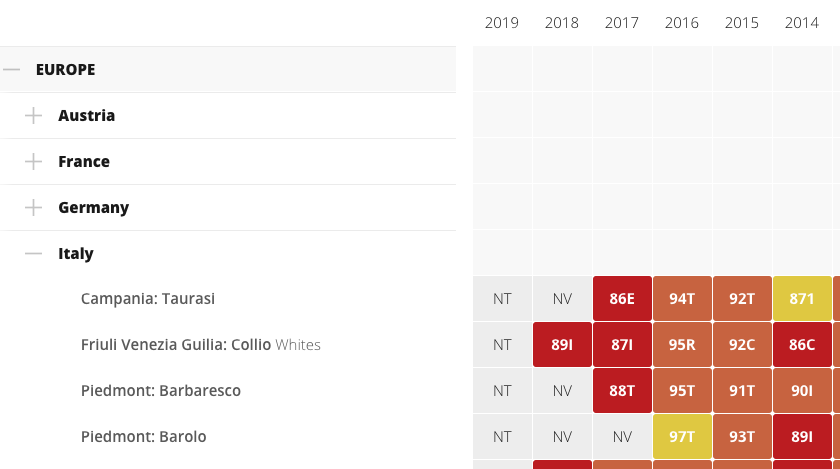Waarom deze wijn?
Jaargang 2016 (score 97 van de 100) overtreft de ook al zo mooie jaargang 2015 (score 93). Dat geldt ook voor de Barolo van Michele Reverdito. Een Barolo van 'the rising star' die in slechts 18 jaar tijd een indrukwekkende Gambero Rosso-reputatie heeft opgebouwd. Voor de liefhebber van een eerlijke, zeer aantrekkelijke en toegankelijke Barolo van het nu al historisch mooie jaar 2015, is dit de kans om snel in te tekenen! Je kunt er direct al van genieten als je wilt.
Beoordeling oogstjaren door Robert Parker:

De smaak
Michele maakt zijn Barolo van handgeplukte Nebbiolo druiven, wilde gisting en twee jaar rijping op oude, eikenhouten 1000-liter vaten. Dit is de traditionele opvoeding die het maximale haalt uit het fruit en terrior van de topwijngaarden van Reverdito. In de heerlijke geur van de wijn ontdek je zwoele, zoete pruimen, specerijen, sinaasappelschil, kirsch, chocolade en kaneel. In de smaak is de wijn krachtig en zacht tegelijk en zo puur dat je alle smaken naast elkaar proeft. De tannines geven de wijn structuur, ze zijn mooie verweven en zacht. Na elke slok geniet je van een mega lange afdronk.
De details
type wijn: full bodied, verfijnd
druivensoort: 100% Nebbiolo
teelt: duurzaam
opvoeding: 2 jaar op eiken houten vaten, 1 jaar op fles
alcoholgehalte: 14 % vol.
afsluiting: natuur kurk
drinktemperatuur: 18 graden
bewaarpotentieel: 2020 - 2030
Spijs-aanbeveling
Deze koninklijke wijn smaakt vorstelijk bij stevige culinaire gerechtenzoals Agnello Ripieni (lamsbout gevuld met kruiden, olijven, spek), wildzwijn met truffel, Chateaux Briand met cantharellen, een gemarmerde rib eye en de kazen Blue Stilton en Gorgonzola Picante.
De oorsprong
Michele Reverdito, betitelt door Gambero Rosso als de 'rising star' van Barolo, heeft een zeer bijzondere prestatie geleverd. In enkele jaren tijd heeft hij zijn familiebedrijf omgebouwd van leverancier van zeer kwalitatieve druiven aan coöperaties tot top Barolo producent. Met zijn verschillende Barolo's en cru's als Bricco Cogni (Tre Bicchieri, Gambero Rosso) Moncucco, Serralunga heeft hij internationale faam behaald (Gambero Rosso, WineSpectator, Wine Enthusiast).
Michele is trots op zijn traditionele manier ('old school') van produceren, inclusief met de hand oogsten en sorteren van druiven, het gebruik van wilde gisten en 1,000 liter vaten om zijn wijnen te laten rijpen. Het karakter van zijn wijnen heeft alles wat je van een traditioneel gemaakte Barolo mag verwachten.; teer, rozen blaadjes, tuigleer, zoete rode kersen en een heerlijke fruitige zuurgraad. Het landgoed van de familie Reverdito omvat ongeveer 20 hectaren waarvan 0.5 ha Alba Dolcetto, 2.5 ha Langhe Nebbiolo, 12 ha Nebbiolo van Barolo en 5 ha Barbera d’Alba.
'In the space of just a few years, this little family-run winery has managed to earn itself a place among the top names in Langhe (Barolo DOCG). Michele Reverdito, aided by his wife and parents, produces a range of well-calibrated, expressive wines with a distintive personality. The top-notch vineyards occupy particularly fine sites and make a decisive contribution to the quality of the estate's production. Its Barolos are, of course, its pride and joy, and are an excellent credential both in Italy and abroad.' Gambero Rosso 2014
De prijzen elders?
Wij vergelijken het voordeel altijd met de prijzen in de online-markt. Belangrijk is dat er dan wel 'appels met appels' worden vergeleken; dus precies dezelfde wijn per 6 flessen van (bij voorkeur) hetzelfde jaar èn bij jou thuisbezorgd (de bezorgtarieven elders zijn meegenomen in de prijscheck).
De prijzen elders?
Wij vergelijken het voordeel met de prijzen in de online-markt. Dat betekent 'appels met appels'; dus precies dezelfde wijn per 6 flessen van (bij voorkeur) hetzelfde jaar èn bij jou thuisbezorgd (de bezorgtarieven elders zijn meegenomen in de prijscheck).
Slimme weetjes: Barolo
Barolo is a traditional hillside village in the rolling hills of Piedmont, north-western Italy. The vineyards and cantine (wineries) there have long been famous for producing some of Italy's very finest red wines – predominantly from the region's signature grape variety, Nebbiolo. Fragrant, tannic Barolo wine is so revered that it was one of just three wines awarded DOCG status on the day that the classification was introduced in July 1980 (the other two were Brunello di Montalcino and Vino Nobile di Montepulciano).
The Barolo vineyard zone covers the parishes of Castiglione Falletto, Serralunga d'Alba and Barolo itself, and also spreads over into parts of Monforte d'Alba, Novello, La Morra, Verduno, Grinzane Cavour, Diano d'Alba, Cherasco and Roddi. The soils and mesoclimates vary slightly between these communes, creating subtle differences between the wines produced from their vineyards.
To earn the name Barolo, the wines must undergo at least 38 months' aging prior to commercial release, of which 18 must be spent in barrel (the remainder in bottle). For the added designation of riserva, the total aging time increases to 62 months. As the tannins soften over time, the complexity shows through with hints of earth, truffles and dark chocolate.
From Wikipedia, the free encyclopedia.
Slimme weetjes: De Nebbiolo (Barolo) druif
Nebbiolo is the grape variety behind the top-quality red wines of Piedmont, northwestern Italy, the most notable of which are Barolo and Barbaresco. Nebbiolo wines are distinguished by their strong tannins, high acidity and distinctive scent – often described as "tar and roses". A less obvious characteristic, visible only over time, is their tendency to lose color. Within just a few years of vintage, most Nebbiolo wines begin fading from deep, violet-tinged ruby to a beautiful brick orange.
From Wikipedia, the free encyclopedia.
Slimme weetjes: De Langhe Piemonte
The Langhe (Langa from old dialect Mons Langa et Bassa Langa) is a hilly area to the south and east of the river Tanaro in the province of Cuneo in Piedmont, northern Italy. It is famous for its wines, cheeses, and truffles—particularly the white truffles of Alba. The countryside as it was in the first half of the 20th Century features prominently in the writings of Beppe Fenoglio and Cesare Pavese, who was born there, in Santo Stefano Belbo.
From Wikipedia, the free encyclopedia.

